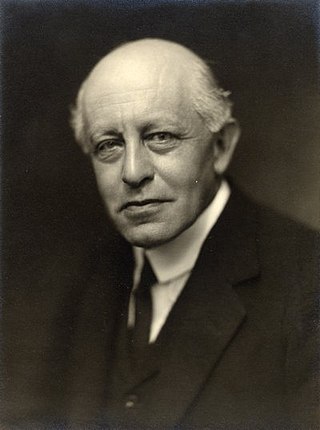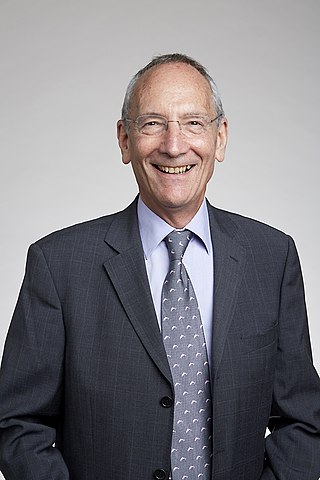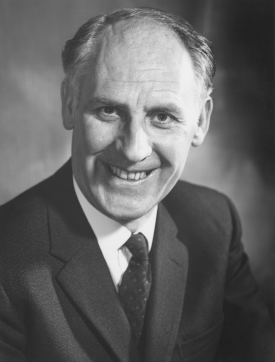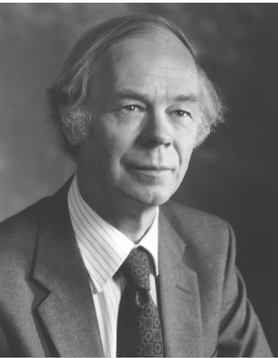Related Research Articles

Antony Hewish was a British radio astronomer who won the Nobel Prize for Physics in 1974 for his role in the discovery of pulsars. He was also awarded the Eddington Medal of the Royal Astronomical Society in 1969.
Horace Basil Barlow FRS was a British vision scientist.

Charles Samuel Myers, CBE, FRS was an English physician who worked as a psychologist. Although he did not invent the term, his first academic paper, published by The Lancet in 1915, concerned shell shock. In 1921 he was co-founder of the National Institute of Industrial Psychology.

Sir Alan Roy Fersht is a British chemist at the MRC Laboratory of Molecular Biology, Cambridge, and an Emeritus Professor in the Department of Chemistry at the University of Cambridge. He was Master of Gonville and Caius College, Cambridge from 2012 to 2018. He works on protein folding, and is sometimes described as a founder of protein engineering.
Alexander Henry Green FRS was an English geologist.

The Ascension Parish Burial Ground, formerly known as the burial ground for the parish of St Giles and St Peter's, is a cemetery off Huntingdon Road in Cambridge, England. Many notable University of Cambridge academics are buried there, including three Nobel Prize winners.

Anthony William Fairbank Edwards, FRS is a British statistician, geneticist and evolutionary biologist. He is the son of the surgeon Harold C. Edwards, and brother of medical geneticist John H. Edwards. He has sometimes been called "Fisher's Edwards" to distinguish him from his brother, because he was mentored by Ronald Fisher. Edwards has always had a high regard for Fisher's scientific contributions and has written extensively on them. To mark the Fisher centenary in 1990, Edwards proposed a commemorative Sir Ronald Fisher window be installed in the Dining Hall of Gonville & Caius College. When the window was removed in 2020, he vigorously opposed the move.

Sir Rowland Harry Biffen FRS was a British botanist, mycologist, geneticist and a professor of agricultural botany at the University of Cambridge who worked on breeding wheat varieties. He was also a gifted artist known for his landscapes in watercolours. He was the founder of the Journal of Agricultural Science.

Stafford Louis Lightman has been Professor of Medicine, University of Bristol, since 1993. He was president of the British Neuroscience Association 2017–2019.
Gordon Miller Bourne Dobson was a British physicist and meteorologist who did important work on ozone.

William Albert Hugh Rushton FRS was professor of Physiology at Trinity College, Cambridge. His main interest lay in colour vision and his Principle of Univariance is of seminal importance in the study of perception.

Michael Francis "Mike" Land FRS was a British neurobiologist. He was a professor of neurobiology in the vision laboratory at the Sussex Centre for Neuroscience, University of Sussex, England.

Raymond Hide was a British physicist, who was a professor of physics at the University of Oxford and, since 2000, senior research investigator at Imperial College, London.
Michael John Whelan HonFRMS FRS FInstP is a British scientist.

Alan Cowey FMedSci, FRS was a British scientist and academic, and the Emeritus Professor of Physiological Psychology at the University of Oxford. His primary interest was in the way in which we interpret the visual world. He gained a BA from the University of Cambridge in 1957 and a PhD from Cambridge in 1961. He was elected a Fellow of the Royal Society in 1988, and a Fellow of the Academy of Medical Sciences in 1998. In 2000 he received an honorary DSc from the University of Durham, and in 2007 he presented the Royal Society's Ferrier Lecture.
Timothy John Pedley is a British mathematician and a former G. I. Taylor Professor of Fluid Mechanics at the University of Cambridge. His principal research interest is the application of fluid mechanics to biology and medicine.
Christine Elizabeth Holt is a British developmental neuroscientist.

Peter Gray FRS was Professor of Physical Chemistry at the University of Leeds and subsequently Master of Gonville and Caius College, Cambridge.
Sir Harry Work Melville, was a British chemist, academic, and academic administrator, who specialised in polymer research. He spent his early career in academia as a lecturer and researcher, before moving into administration as a civil servant and university college head.

John S. Werner is an American scientist who studies human vision and its changes across the life span. He is a Distinguished Professor at the University of California, Davis in the Department of Ophthalmology and Vision Science, and Department of Neurobiology, Physiology and Behavior. His work has been cited ~ 17,000 times.
References
- 1 2 List of Fellows of the Royal Society
- 1 2 3 4 5 6 7 8 9 10 11 Authorised entry in Debretts
- ↑ Google Citations
- ↑ "Mollon, John — Medicine | Caius College Cambridge". Archived from the original on 2 April 2015. Retrieved 14 December 2014. Gonville and Caius list of the current Master and Fellows
- ↑ Article from the Gonville and Caius website
- ↑ List of College Officers at Gonville and Caius
- ↑ "Cambridge database of natural spectra". University of Cambridge: Vision Lab. Retrieved 18 August 2021.
- ↑ Web page of the University of Durham